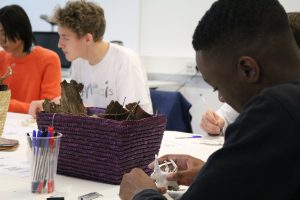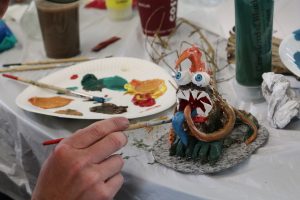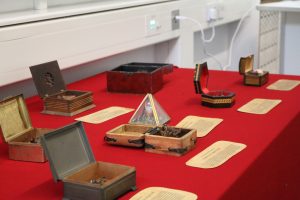Lab Contact: Katherine Wimpenny
Overview
Curious Oddities explored students’ self-representation through creative arts pedagogy. Under the facilitation of Tom Ellis, a Birmingham-based Artist; students from across campus were asked to create imaginative and curious 3D sculptures. These natural, personal and unconventional creative forms of representation offered induction students opportunity to reflect upon their ideas and values as they started their higher education journey.
Curious Oddities was trialled as a pilot project with three, first-year, undergraduate courses from Engineering and Health disciplines with positive feedback from students who engaged in the process.
Download Project PDF Report
Project Focus
The project provided a rich example of how creative learning might contribute to enriching students’ self-reflective learning and practice.
Tom’s Curious Oddities are about making things and crafting things, using materials, scratch-built, from found objects, which he uses to invent and create curious arts forms. These natural, personal and unconventional forms of representation are offered to challenge ones ideas, to explore characterful representations and to reflect on our senses.
Aims
The key research aims were to:
- Understand the benefits of creative arts pedagogy to enhance teaching and learning experiences from the perspectives of student participants involved across the disciplinary domains.
- To uncover and reformulate what arts-related experiences offer students within teaching and learning, how it is exemplified, and if, and how, new perspectives emerge and develop during the project.
- To examine the learning gains created through the interaction between the participants, artist, staff DMLL research staff, arising in, through, and from the project.
Tom facilitated a series of workshops with first-year students during induction week at the start of their Coventry University journey. We wanted to attend to issues about self and identity and ‘beginning’ stories using exploratory, creative means. We wanted to promote students’ insight into their ‘educational self’, to design their own ‘curious oddity’, accompanied with a short story about the sculpture. We also wanted students to play, have fun, to socialise with others whilst thinking about different ways of ‘knowing’, and how creative meaning-making might influence learning experiences.



Key Findings
The findings from the quantitative and qualitative data focus on the students’ overall learning experience and are presented in five overarching themes:
- Learning through new experiences
This theme represents the students’ response towards a new learning opportunity. Many provided thoughtful and very positive feedback about the use of creative methodologies in their learning process, which highlight the importance of further research about this topic. It also demonstrated the importance that students place on a cross-disciplinary approach, lateral-thinking and new skill acquisition in their own learning and for future practice. - Using creativity and imagination
The ‘create’ and ‘imagine‘ aspects of the workshops were very well received and this seemed to encourage student engagement. Prior to the workshops, many students expressed concern about their creative ability and if they could achieve a ‘good result’ or ‘any result at all’. After the workshops, students expressed a new-found sense of self-worth and appreciation for the acquisition of new skills, demonstrating that the students had overcome the original barriers and fears that they had regarding their engagement with the project.All students agreed that creative educational approaches could benefit their current studies. - Meeting new people and working with others
It was evident that having space for meeting peers and socializing during induction week, was clearly an important element of the project for the students. Further, engaging in a creative task during the induction process was welcomed. Through making and creating, students interacted with one another, gaining new perspectives from how their peers approached the task at hand, prompting participants to reflect on their skills and abilities. It further focused on the impact of group participation and students working towards learning outcomes, commenting as they progressed, upon how they related to the creative task, whilst finding out more about one another’s previous experiences, thoughts about the course, settling into university life etc. - Expressing myself and communicating
The students reflected upon their values and learning journey. Their feedback described the enhanced sense of awareness, connectedness and communication the students experienced as a result of being involved in the project. This theme illustrates the learner gains the project offered the students and the resulting insight it offered them about the way they express and communicate with others. - Fun and engagement
Students reported on how their experience of the workshops had offered a fun, relaxing and even ‘therapeutic’ experience as part of their induction to the university. An appreciation of non-traditional educational practices and experiences began to emerge. Students were clearly beginning to consider the positive implications for their studies, and considering how creative practice might be applied in different educational and professional contexts.
Key Messages
This project aimed to facilitate students’ confidence as creative individuals and to examine the value of creative methodologies in the learning process.
Working in cross-disciplinary groups offered students opportunities to interact with other students’ and to share how each one interpreted the task. As the students engaged with one another and encountered difference in fellow student perspectives, purposeful opportunities to interact were enabled. The creative space and place provided students with the opportunity to let their imagination flow, to appreciate the value of ‘knowing and experience’ through making curious forms, and for the emergence of alternative ways of representation of the self, and new discourses to emerge.
Having a practical, creative, hands-on task enabled students to explore and reflect upon their ideas about being a student, engaging with their discipline, through accessing students first person narratives, exploring and revealing personally held beliefs and values.
Where students have done well they clearly grasp the notion that the profession needs to be viewed within a self-reflective context.
Creative/artistic learning with students with the traditional arts disciplines, offers learning platforms and methods that can enhance and invigorate learning to ensure currency, interest and engagement within the curriculum.
Timeline
Pre-week: Enrolment
- Pilot workshops will take place during induction week
- Due to student numbers on OT programme (approx. 200) Katherine and Tom were invited into launch lectures for OT students to promote and recruit to the workshops.
- EEC worships were in-built and timetabled
Session One: Clay modelling undertaken
- Two-hour workshops - maximum twenty students per session
- HLS recruited students to two workshops
- M.Eng. students were timetabled
Session Two: Fired objects returned and narrative created
- Two-hour workshops - maximum twenty students per session
- HLS two workshops
- All M.Eng. students timetabled
Follow-up and feedback
- Opportunity for students to keep in contact with Tom
- Project promoted on DMLL website for artefact creation and linkage for student’s discussions
Associated Faculties, Schools and/or Course(s):
- Faculty of Engineering, Environment and Computing
- Faculty of Health and Life Sciences
